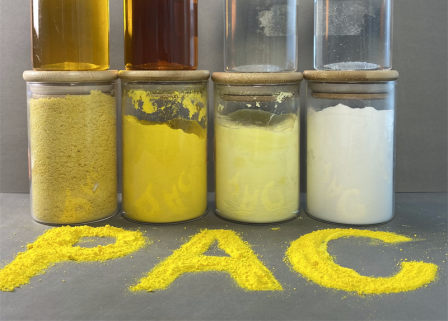There are many users to consult the manager of our new ring company by phone: what kind of water treatment chemicals are good for treating sewage? The manager will give them a careful explanation: what kind of water treatment chemicals for sewage treatment is good, according to different manufacturers, different turbidity, different PH value, different raw materials produced by the sewage for a small test, choose the water treatment chemicals products suitable for their needs. We commonly used water treatment chemicals to count polyaluminum chloride PAC products. Because polyaluminum chloride is a kind of multi-hydroxyl, multi-nuclear complex cationic inorganic polymer flocculant, solid product appearance of reddish-brown, yellow or white solid powder, its chemical molecular formula is [AL2(OH)nCL6-n]m. (in the formula, 1 ≤ n ≤ 5, m ≤ 10), and easily soluble in water, has a strong adsorbent bridging, accompanied by the hydrolysis process of electrochemical, cohesion, adsorption and precipitation, such as physical changes, end up into a new product. In the process of hydrolysis, it is accompanied by electrochemical, coagulation, adsorption, precipitation and other physical changes, and eventually becomes [AL2(OH)3(OH)3], so as to achieve the purpose of purification.
The polyaluminum chloride produced by Xinhuan Chemical Factory can treat the following kinds of sewage:
First, the sewage produced by domestic water, that is, the treatment of washing wastewater. As the water contains a large number of surfactants, this agent, if the oil, dust particles and other interactions and reactions, will form a negatively charged colloidal particles, easy to stabilize the retention in the water. If the appropriate amount of polyaluminum chloride in the wastewater, there will be a large number of positively charged cations, and the formation of multi-core high charge ions, can make the charge suspended on the surface of the colloidal particles have a strong adsorption of electricity and the ability to neutralize the ability of compression of the double layer ability to destabilize the colloidal particles, and then adsorption of the pollutants precipitation and separation of the water body.
Second, the paper mill wastewater treatment. Paper industry wastewater emissions, a large proportion of which comes from the section of water treatment, and there are many paper companies in the black liquor after pretreatment (anaerobic, strong acid treatment, cellulose separation, neutralization, etc.) is also mixed into the section of water together with the treatment. It makes the harmful substances in papermaking wastewater increase. With polyaluminum chloride coagulation and precipitation treatment of paper middle section water, with the increase of salinity, the removal rate of COD and SS increased. It should be noted here that the removal rate turned down after 75% of the salt base degree. At a temperature of 250°C, the addition of polyaluminum chloride with a salinity of 75% of 0.6 gL can make the effluent water meet the discharge standard. In addition, polyaluminum chloride is of practical significance in the treatment of paper wastewater because of its low price and the fact that the slag can be returned to the paper-making process as raw material without secondary pollution and can produce certain economic benefits. It is found that polyaluminum chloride in alkaline (pH 7-9) conditions, when the coagulant dosage is greater than 750mgL, the suspended solids removal rate can reach more than 95%, and can remove 20-50% of CODCr.
Third, printing and dyeing plant wastewater treatment. We are familiar with the printing and dyeing wastewater, with high COD, chromaticity and ph value. Coagulation of its sewage dosing is one of our common treatment methods. Although the coagulation effect of polyaluminum chloride is good, and the dosage we add when using it is relatively low, however, the neutralization ability of polyaluminum chloride on the high alkalinity of printing and dyeing wastewater is poor, and the application is somewhat limited. Through years of research, with the use of two coagulants, the use of both complementary advantages and the synergistic effect of the same ion effect, the treatment of printing and dyeing wastewater can reduce the cost of treatment, while improving the treatment effect.
Fourth, oily wastewater treatment. Oily wastewater mainly refers to the oilfield mining crude oil produced by a large number of extracted water, oil refineries and petrochemical plants discharged oily wastewater and cleaning tankers and vehicles produced by the wastewater containing. Polyaluminum chloride and modified cationic polyacrylamide are used together for coagulation, precipitation and filtration treatment of oily wastewater, which has a very good treatment effect. The relative molecular weight of modified cationic polyacrylamide should not be too high, and it is easy to compound with polyaluminum chloride in order to achieve the ideal effect.

The main products of flocculant manufacturer Xinhuan Water Treatment are:
White polyaluminium chloride (food grade), drinking grade polyaluminium chloride, industrial grade polyaluminium chloride, anionic polyacrylamide, cationic polyacrylamide, nonionic polyacrylamide, petroleum recycling polyacrylamide, oil recovery polyacrylamide, polyacrylamide, polymer flocculant polymer flocculation coagulant, polymeric ferrous sulphate, polymerized iron and aluminium chloride, and other water treatment chemicals. Welcome customers to write to us to negotiate business! Tel/WhatsApp:15936201203 Email:maggie@xhwtm.com Contact:Maggie